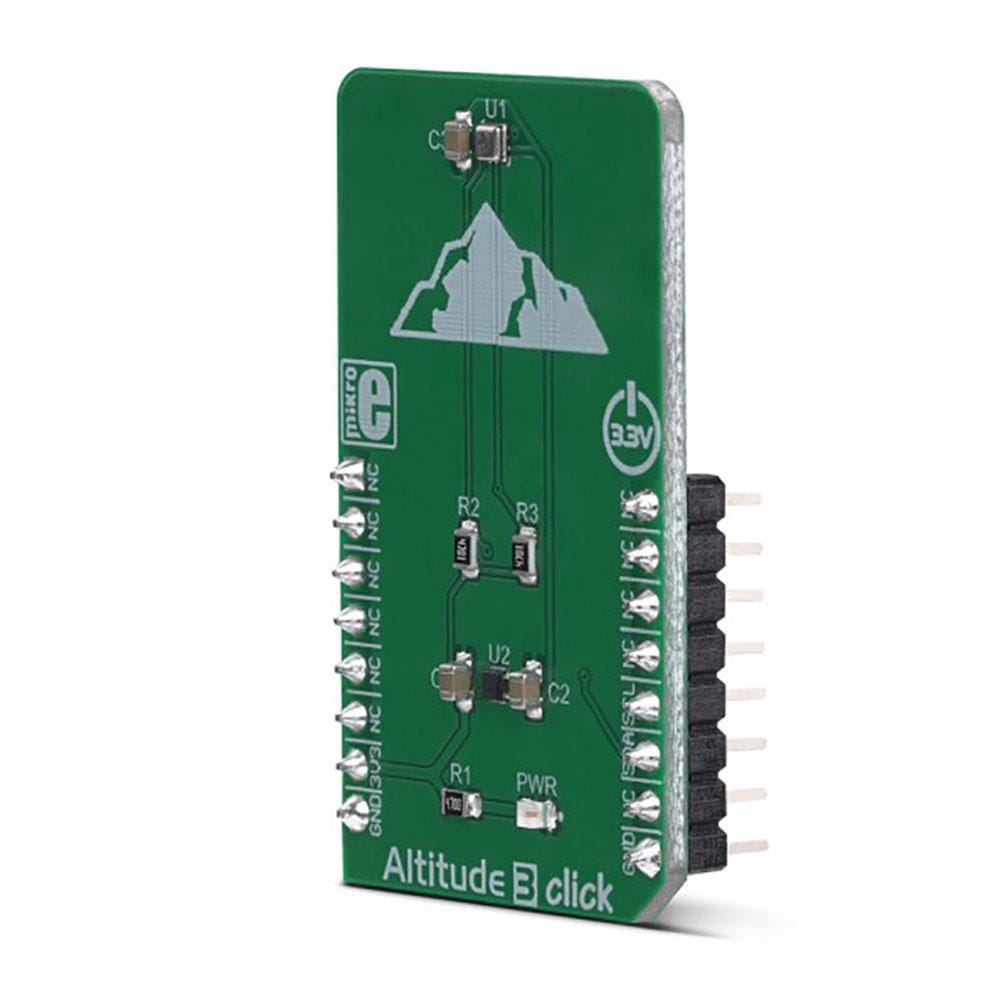
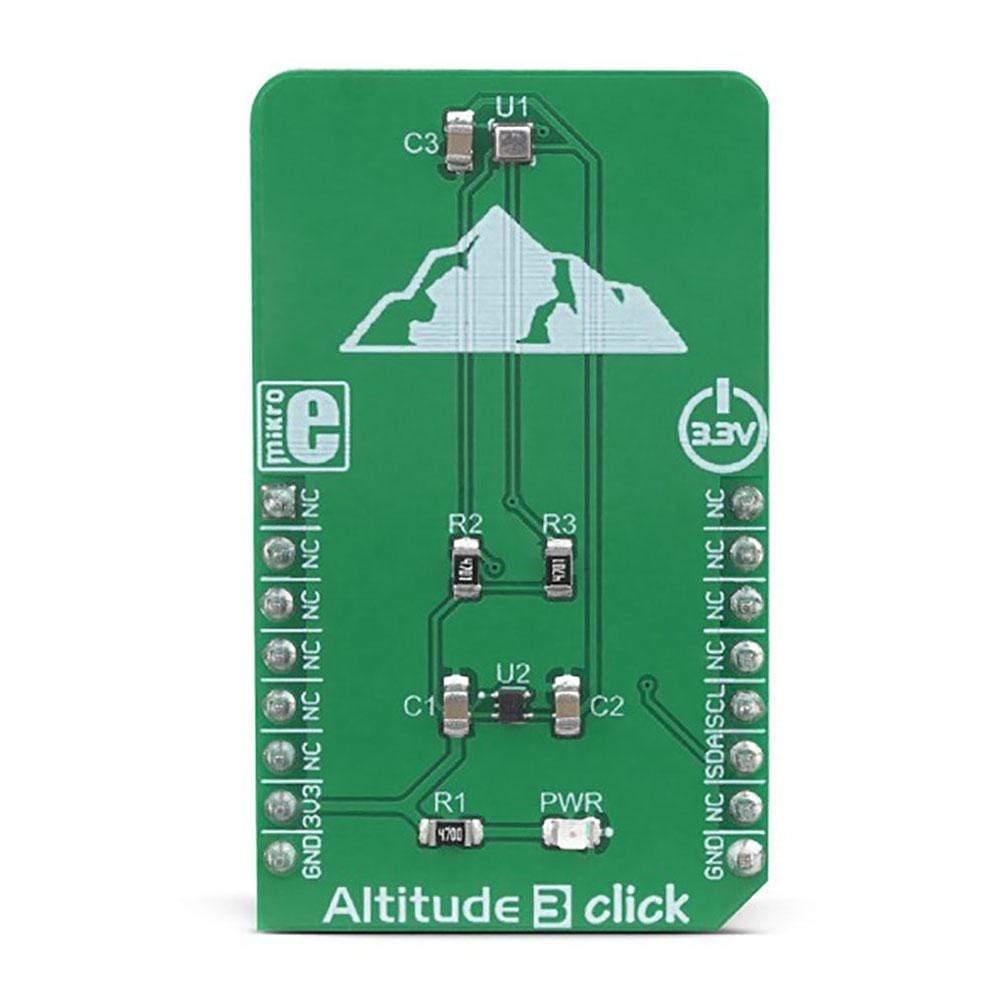
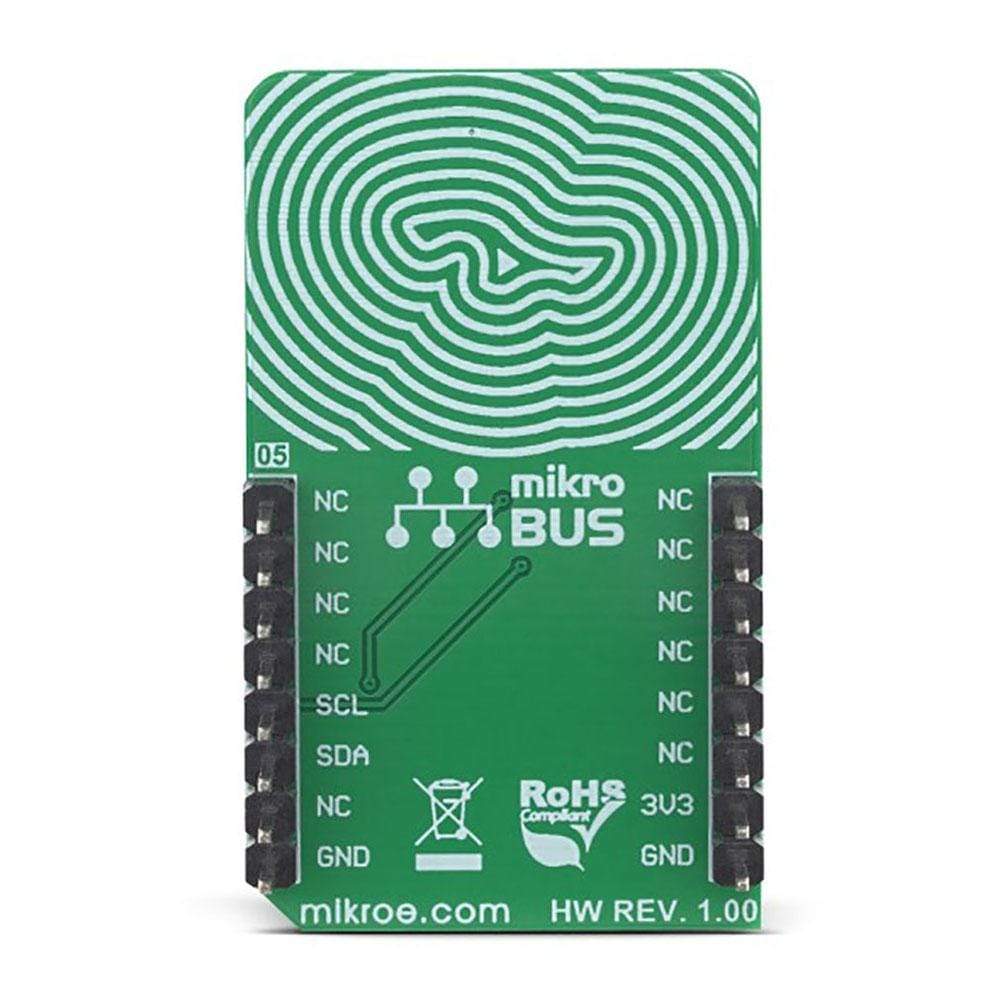
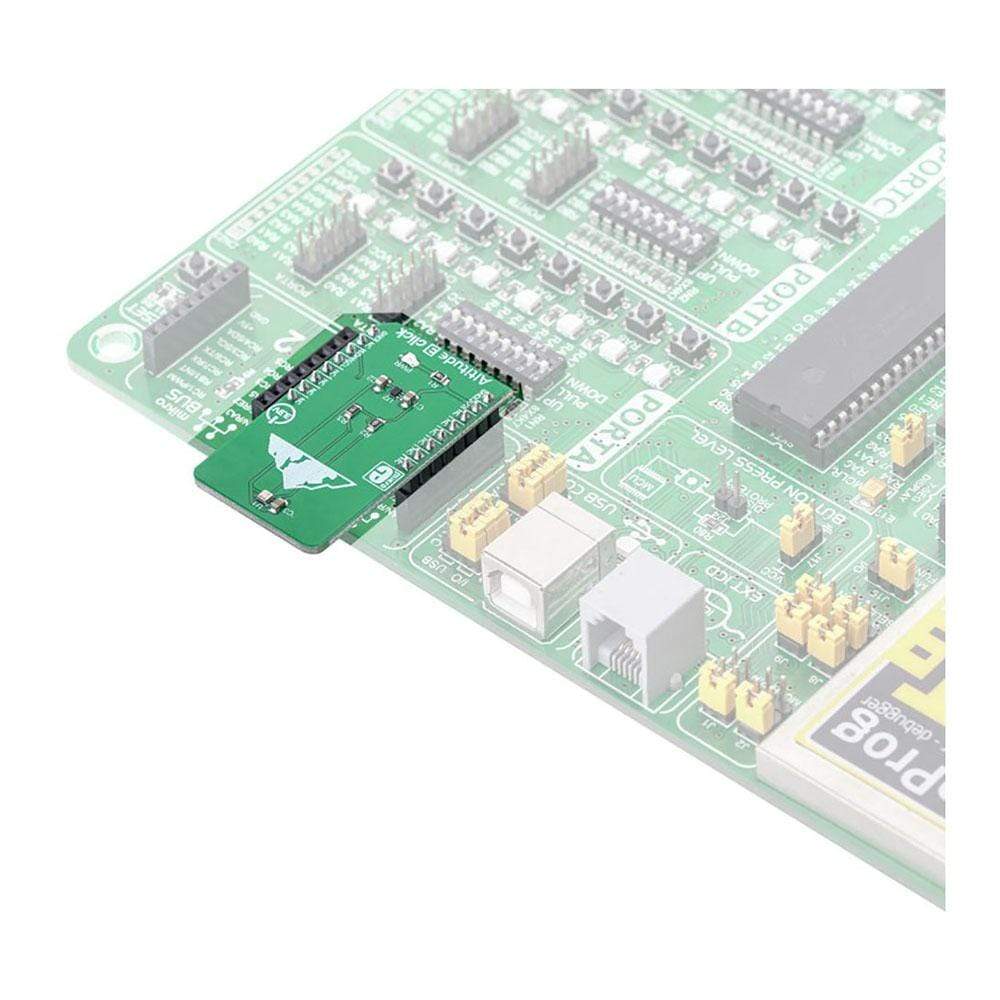
Overview
The Altitude 3 Click Board™ allows high-resolution barometric pressure measurement, by utilizing the ICP-10100, an integrated barometric pressure and temperature sensor. Based on the advanced MEMS capacitive sensing technology, it offers industry-level accuracy and thermal stability. A very high absolute pressure accuracy up to ±1 Pa allows the Altitude 3 Click Board™ to sense very small altitude changes, within the magnitude of about 10 cm. The temperature sensor offers accuracy up to ±0.4°C, in the range from -40°C to 85°C. Low power requirements make it a perfect choice for various battery-operated applications
Downloads
Features such as very high accuracy, low power consumption, temperature stability, water resistance, and more, make Altitude 3 Click Board™ a perfect choice for the development of barometric pressure sensing applications for sports activity identification, mobile indoor/outdoor navigation, altitude-hold and stabilization in drones, and other similar applications that can benefit from the very precise barometric pressure sensor.
How Does The Altitude 3 Click Board™ Work?
The barometric pressure sensor IC used on the Altitude 3 Click Board™ is the ICP-10100, a high accuracy, low power, waterproof barometric pressure and temperature sensor IC, from TDK Corporation. The sensor is manufactured using the ultra-low noise MEMS (Micro Electro Mechanical System) capacitive technology, optimized for precise altitude measurements. It can detect pressure differences with the accuracy of ±1 Pa, which translates to an altitude resolution of less than 10cm. This makes this sensor very usable in drone applications development, allowing it to hover at a fixed altitude, or to be used as the stabilization control. Also, this sensor has a very low temperature offset of only ±0.5 Pa/°C, within the range from 25°C to 45°C.
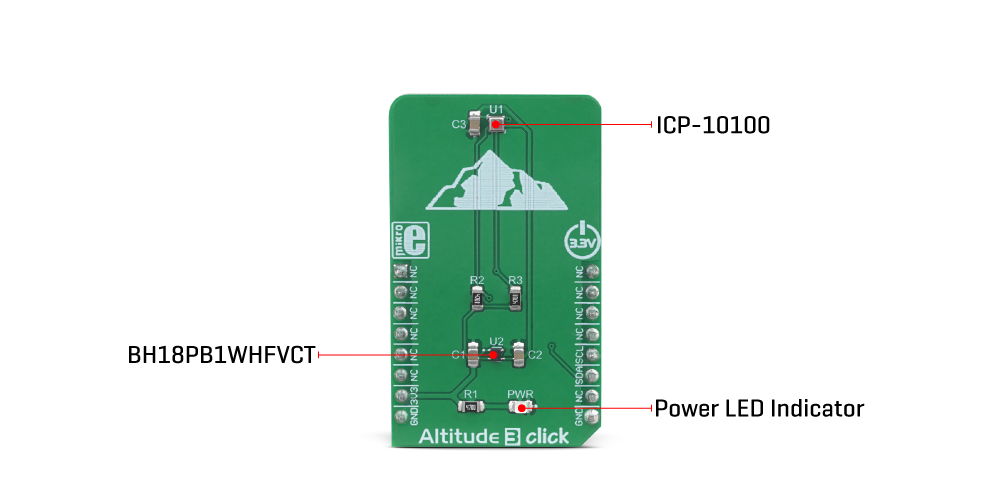
Each sensor IC is factory calibrated and the calibration parameters are stored within the OTP memory. To convert the readings into temperature and pressure values, these coefficients need to be used. The datasheet of the ICP-10100 offers formulas for these calculations. However, the Altitude 3 Click Board™ comes with a library that contains functions that encapsulate these calculations, which greatly accelerates application development.
Being packaged in a waterproof casing, the ICP-10100 sensor allows it to be used under 1.5m of water for the duration of 30 minutes. However, since the Click board™ itself is not waterproof, the sensor still offers good resistance against increased humidity and moisture. The ICP-10100 sensor offers the best performance when operated within the normal pressure and temperature conditions within the range from 0°C to 45°C, and from 95 kPa to 105 kPa.
The ICP-10100 can be operated in four different modes, allowing its performance to be tailored according to specific requirements. These modes allow a compromise between high precision, low noise, output speed, and power consumption. These modes include Low Power mode (LP), Normal mode (N), Low Noise mode (LN) and Ultra-Low-Noise mode (ULN). The datasheet of the ICP-10100 contains a table that displays the conversion time, current consumption, and pressure measurement noise for each of these modes, allowing the optimal mode to be chosen.
The Altitude 3 Click Board™ uses the I2C protocol to communicate with the host MCU. It contains two pull-up resistors for each of the I2C lines. The ICP-10100 is operated with only 1.8V. To provide this voltage, an additional IC had to be used. The BH18PB1WHFVCT is a small LDO regulator, providing the required voltage for the ICP-10100. Both I2C lines of the pressure sensor IC are pulled up to a 3.3V power rail though, allowing it to be operated by most MCUs that typically use 3.3V logic voltage levels. Please note that the Click board™ supports only 3.3V MCUs and it is not intended to be controlled with MCUs that use 5V without a proper level shifting circuitry.
SPECIFICATIONS
| Type | Altitude,Pressure |
| Applications | The Altitude 3 Click Board™ is a perfect choice for the development of barometric pressure sensing applications for sports activity identification, mobile indoor/outdoor navigation, altitude-hold in drones, and other similar applications that can benefit from a precise barometric pressure sensor |
| On-board modules | ICP-10100, a high accuracy, low power, waterproof barometric pressure and temperature sensor IC, from TDK corporation |
| Key Features | Low power consumption, high measurement accuracy, factory calibrated compensation coefficients, high repeatability of the measurement data, water and moisture resistance, and more |
| Interface | I2C |
| Compatibility | mikroBUS |
| Click board size | M (42.9 x 25.4 mm) |
| Input Voltage | 3.3V |
PINOUT DIAGRAM
This table shows how the pinout of the Altitude 3 Click Board™ corresponds to the pinout on the mikroBUS™ socket (the latter shown in the two middle columns).
| Notes | Pin |  |
Pin | Notes | |||
|---|---|---|---|---|---|---|---|
| NC | 1 | AN | PWM | 16 | NC | ||
| NC | 2 | RST | INT | 15 | NC | ||
| NC | 3 | CS | RX | 14 | NC | ||
| NC | 4 | SCK | TX | 13 | NC | ||
| NC | 5 | MISO | SCL | 12 | SCL | I2C Clock | |
| NC | 6 | MOSI | SDA | 11 | SDA | I2C Data | |
| Power Supply | +3V3 | 7 | 3.3V | 5V | 10 | NC | |
| Ground | GND | 8 | GND | GND | 9 | GND | Ground |
ALTITUDE 3 CLICK ELECTRICAL SPECIFICATIONS
| Description | Min | Typ | Max | Unit |
|---|---|---|---|---|
| Pressure range (extended/maximum) | 30 (25) | - | 110 (115) | kPa |
| Pressure measurement resolution | - | 0.01 | Pa | |
| Absolute pressure accuracy (normal/extended range) | -1 (-1.5) | - | 1 (1.5) | Pa |
| Temperature range | -40 | - | 85 | ˚C |
| Temperature accuracy | -0.4 | - | 0.4 | ˚C |
ONBOARD SETTINGS AND INDICATORS
| Label | Name | Default | Description |
|---|---|---|---|
| LD1 | PWR | - | Power LED indicator |
| General Information | |
|---|---|
Part Number (SKU) |
MIKROE-3328
|
Manufacturer |
|
| Physical and Mechanical | |
Weight |
0.018 kg
|
| Other | |
Country of Origin |
|
HS Code Customs Tariff code
|
|
EAN |
8606018714308
|
Warranty |
|
Frequently Asked Questions
Have a Question?
Be the first to ask a question about this.




